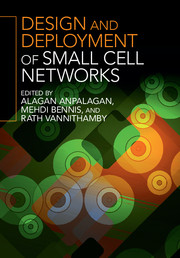Book contents
- Frontmatter
- Contents
- List of contributors
- Preface
- 1 Mobility performance optimization for 3GPP LTE HetNets
- 2 Design and performance analysis of multi-radio small cell networks
- 3 Dynamic TDD small cell management
- 4 3GPP RAN standards for small cells
- 5 Dense networks of small cells
- 6 Traffic offloading scenarios for heterogeneous networks
- 7 Required number of small cell access points in heterogeneous wireless networks
- 8 Small cell deployments: system scenarios, performance, and analysis
- 9 Temporary cognitive small cell networks for rapid and emergency deployments
- 10 Long-term evolution (LTE) and LTE-Advanced activities in small cell networks
- 11 Game theory and learning techniques for self-organization in small cell networks
- 12 Energy efficient strategies with BS sleep mode in green small cell networks
- 13 Mobility management in small cell heterogeneous networks
- 14 The art of deploying small cells: field trial experiments, system design, performance prediction, and deployment feasibility
- 15 Centralized self-optimization of interference management in LTE-A HetNets
- 16 Self-organized ICIC for SCN
- 17 Large-scale deployment and scalability
- 18 Energy efficient heterogeneous networks
- 19 Time- and frequency-domain e-ICIC with single- and multi-flow carrier aggregation in HetNets
- Index
- References
15 - Centralized self-optimization of interference management in LTE-A HetNets
Published online by Cambridge University Press: 05 December 2015
- Frontmatter
- Contents
- List of contributors
- Preface
- 1 Mobility performance optimization for 3GPP LTE HetNets
- 2 Design and performance analysis of multi-radio small cell networks
- 3 Dynamic TDD small cell management
- 4 3GPP RAN standards for small cells
- 5 Dense networks of small cells
- 6 Traffic offloading scenarios for heterogeneous networks
- 7 Required number of small cell access points in heterogeneous wireless networks
- 8 Small cell deployments: system scenarios, performance, and analysis
- 9 Temporary cognitive small cell networks for rapid and emergency deployments
- 10 Long-term evolution (LTE) and LTE-Advanced activities in small cell networks
- 11 Game theory and learning techniques for self-organization in small cell networks
- 12 Energy efficient strategies with BS sleep mode in green small cell networks
- 13 Mobility management in small cell heterogeneous networks
- 14 The art of deploying small cells: field trial experiments, system design, performance prediction, and deployment feasibility
- 15 Centralized self-optimization of interference management in LTE-A HetNets
- 16 Self-organized ICIC for SCN
- 17 Large-scale deployment and scalability
- 18 Energy efficient heterogeneous networks
- 19 Time- and frequency-domain e-ICIC with single- and multi-flow carrier aggregation in HetNets
- Index
- References
Summary
In this chapter we address interference mitigation in LTE-A co-channel Het-Net deployments, a major issue for reaching substantial capacity enhancements. We provide an extensive literature survey of the existing co-channel interference mitigation methods involving optimization of the related network parameters, resulting in corresponding improvements in quality of service (QoS). Since the number of base stations (macro, micro, pico, and femto) increases considerably in a HetNet deployment, optimization of network parameters with such a high number of nodes becomes complex and costly, calling for the inevitable need for self-optimization. We propose a self-optimization framework based on efficient statistical modeling combined with robust sequential optimization, which is very suitable for implementation in a centralized manner at the operator's management plane. In particular, the proposed methodology is based on the following two concepts, which will be described in detail.
Modeling of the functional relationships between network parameters and relevant key performance indicators (KPIs) by using a statistical modeling technique called Kriging.
Optimization of the KPIs through these statistical relationships by using a pattern search algorithm.
The proposed methodology is applied to two interference mitigation techniques, namely enhanced inter-cell interference coordination and active antenna systems-based interference mitigation, and their comparative performances are analyzed.
Introduction
Mobile usage and data traffic is increasing globally at a remarkably fast rate. Ericsson reported data traffic to almost have doubled between 2012 and 2013 and the industry is preparing for a 1,000 times increase by 2020 [1]. Given the rise in traffic demand, the industry is looking for solutions to challenges both in technological as well as in managerial aspects of a network.
Until recently, a part of this challenge was addressed by increasing the number of sites that could be deployed in a given area and on a given frequency. However, the rise in interference has prevented further densification in a given radio access network (RAN). Furthermore, installations of new base stations transmitting on high power has become a societal issue. Of course, the bandwidth can be expanded by adding additional spectrum, but this solution again involves economical factors apart from the issue of limitations in the amount of bandwidth available for bracing a challenge of 1,000 times traffic rise.
- Type
- Chapter
- Information
- Design and Deployment of Small Cell Networks , pp. 363 - 392Publisher: Cambridge University PressPrint publication year: 2015



